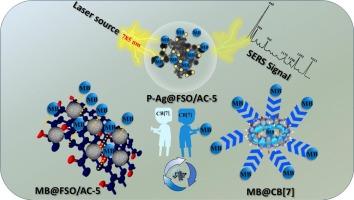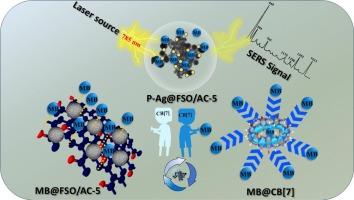熔融多功能纤维SiO2/活性炭复合材料的SERS和选择性污染物吸附
IF 6.9
2区 材料科学
Q2 CHEMISTRY, PHYSICAL
引用次数: 0
摘要
表面增强拉曼散射(SERS)是一种检测痕量染料分子的强大技术。通过使用高效底物吸附去除这些染料对于环境应用同样至关重要。在本研究中,用纳米银(Ag NPs)修饰纤维SiO2 (FSO)和活性炭(AC)复合材料,制备纸(P)条。P-Ag@FSO/AC-5复合材料可有效检测低至10−9 M浓度的亚甲基蓝(MB), SERS增强因子(EF)高达2.88 × 107。这些试纸条也能有效检测罗丹明B(10−8 M)和甲基橙(10−6 M)。FSO的纤维形态促进了Ag NPs的吸附,形成了高效的sers活性“热点”,而AC的多孔结构增强了Ag表面附近MB的吸附。结果,P-Ag@FSO/AC-5在使用10−5 M MB溶液时表现出比P-Ag@FSO (EF: 1.66 ×104)更强的拉曼信号(EF: 1.86 ×104)。在吸附研究中,FSO/AC-5在80 min内去除95 %的MB,容量为207.46 mg g−1。在混合染料体系中甲基橙对MB的选择性吸附效率达到85.07 %。此外,mb负载的FSO/AC-5作为cucbit [7]uril (CB[7])的视觉传感器,在10 - 6 m下检测它。因此,当与等离子体纳米银功能化时,FSO/ ac基复合材料表现出双重功能,即作为染料去除的有效吸附剂和作为分子检测的敏感SERS底物。本文章由计算机程序翻译,如有差异,请以英文原文为准。


Fused multifunctional fibrous SiO2/activated carbon composites for SERS and selective pollutant adsorption
Surface enhanced Raman scattering (SERS) is a powerful technique for detecting dye molecules at trace levels. The removal of these dyes through adsorption using efficient substrates remains equally critical for environmental applications. In this study, paper (P) strips were fabricated by decorating fibrous SiO2 (FSO) and activated carbon (AC) composites with silver nanoparticles (Ag NPs). The P-Ag@FSO/AC-5 composite effectively detected methylene blue (MB) at levels as low as 10−9 M, exhibiting a high SERS enhancement factor (EF) of 2.88 × 107. These paper strips could also detect rhodamine B (10−8 M) and methyl orange (10−6 M) effectively. The fibrous morphology of FSO facilitated Ag NPs entrapment, creating efficient SERS-active “hotspots,” while the porous structure of AC enhanced MB adsorption near the Ag surface. As a result, P-Ag@FSO/AC-5 exhibited stronger Raman signals (EF: 1.86 ×104) compared to P-Ag@FSO (EF: 1.66 × 104) when tested using 10−5 M MB solution. In adsorption studies, FSO/AC-5 removed 95 % of MB within 80 min, with a capacity of 207.46 mg g−1. Its selective adsorption efficiency for MB over methyl orange in mixed dye systems reached 85.07 %. Furthermore, MB-loaded FSO/AC-5 functioned as a visual sensor for Cucurbit[7]uril (CB[7]), detecting it at 10−6 M. Thus, FSO/AC-based composites, when functionalized with plasmonic silver nanoparticles, demonstrate dual functionality as efficient adsorbents for dye removal and as sensitive SERS substrates for molecular detection.
求助全文
通过发布文献求助,成功后即可免费获取论文全文。
去求助
来源期刊

Applied Surface Science
工程技术-材料科学:膜
CiteScore
12.50
自引率
7.50%
发文量
3393
审稿时长
67 days
期刊介绍:
Applied Surface Science covers topics contributing to a better understanding of surfaces, interfaces, nanostructures and their applications. The journal is concerned with scientific research on the atomic and molecular level of material properties determined with specific surface analytical techniques and/or computational methods, as well as the processing of such structures.
 求助内容:
求助内容: 应助结果提醒方式:
应助结果提醒方式:


